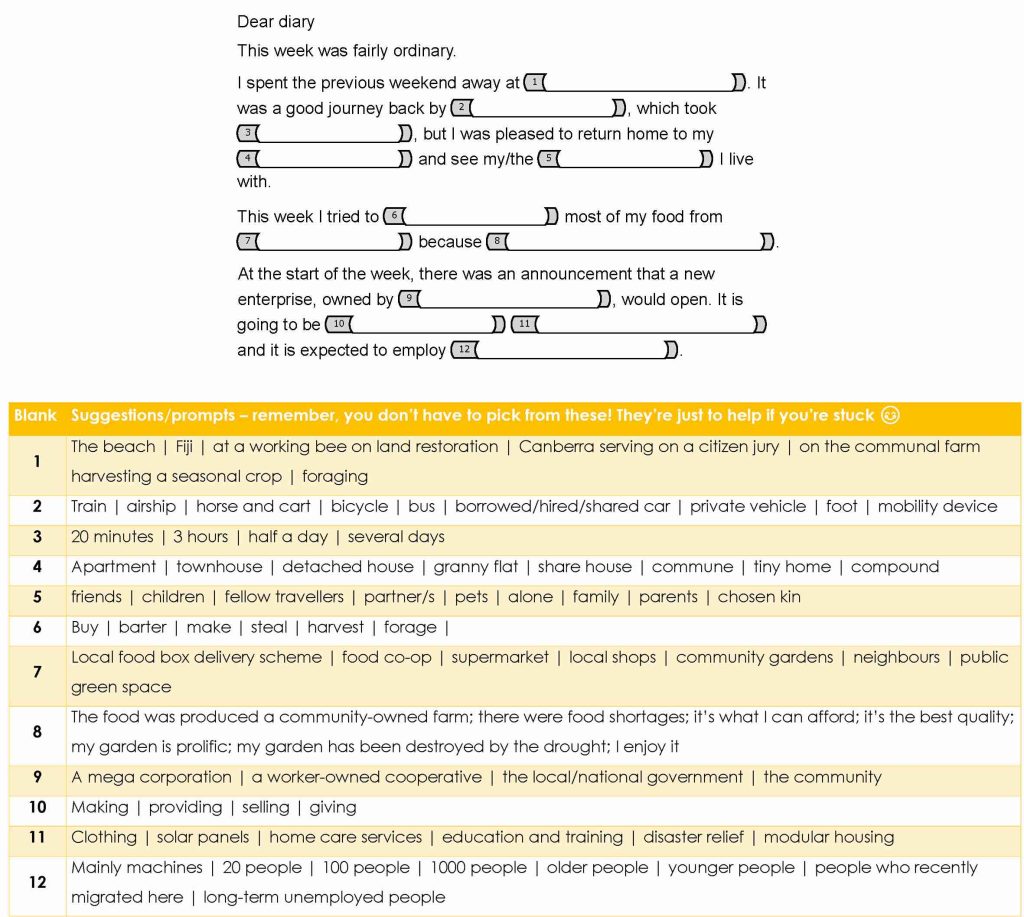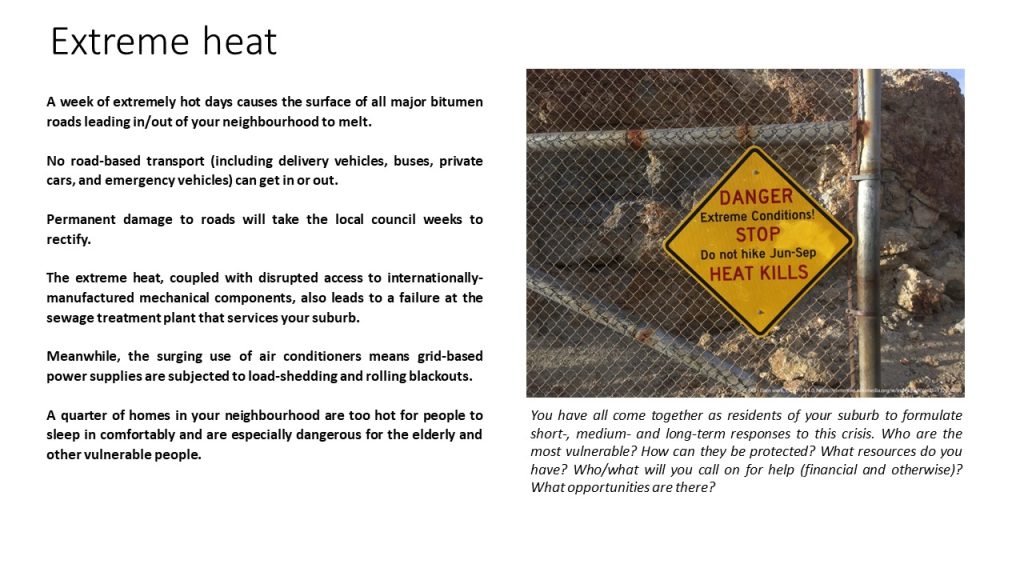If, in the future, we would like to be able to safely house climate refugees in our neighbourhoods, what do we need to be agitating for now? What needs to change in how we understand housing, property, and the right to safe shelter? What do we need to unlearn in settler-colonial entitlement and domination, what racism and xenophobia must we address, to ensure we can respond to need without acting defensively and violently? Informed by abolitionist and transformative justice thinking and work, we organised a workshop at the Green Institute conference to vision futures.
Helping people to imagine a different city of the future is essential for positive transformative shifts in response to climate change, biodiversity loss and the other multiple and cascading crises. Creating futures that are neither utopian and unrealistic, nor dystopian and depressing, can help people see potential solutions and even opportunities in the midst of what appears to be only an ocean of problems. A recent future visioning workshop at the 2023 Green Institute Conference highlighted the importance of, and challenges to, building communities in our cities to help us face the future.
The Need to Transform
There is a growing recognition of the need for transformation. Multiple interconnected crises, hastened by rapidly worsening climate change, threaten to destabilise our current institutions, raising questions as to whether they are fit-for-purpose. The latest IPCC report identified ‘Complex, Compound and Cascading Risks’ as a key impact of climate change (IPCC, 2022) and it is all too easy to imagine dystopian futures of reactionary politics and even collapse. Biodiversity loss may potentially be an even greater crisis, while more immediate cost-of-living, housing and other economic challenges, accompanied by growing wealth inequality, places us firmly in the midst of an equity crisis that again strains our inertia-heavy institutions, as people see them as no longer fair.
We know that slow, incremental change will fail to stave off the biophysical disruptions we face (IPCC, 2022). Some level of climate change is ‘baked in’ – change, and potentially transformative change is coming whether we want it or not (IPCC, 2022). No matter how resilient we think we are, bouncing-back is no longer an option. The same may very well be true of our social and economic crises. We may risk locking in a ‘Great Unravelling’ of multiple systems collapsing, and the dystopian futures of so many sci-fi films and books loom alarmingly on the horizon. These futures offer us little in the way of solutions to our crises, and even less in the way of hope.
Positive Transformation
At the same time, active transformation, choosing radical and significant shifts to institutions and social structures, provides us with the tools to manage this change to ‘bounce forward’ to something altogether different, but potentially better – more sustainable, more equitable, more just. ‘Active hope’ could create a ‘Great Turning’ – a transformation to heal and recover (Macy & Johnstone, 2022), partly by ‘liberating ourselves and institutions’ (Watkins & Shulman, 2008). Such active hope needs nurturing, however, and as part of this we need to be able to imagine new and alternative institutions and structures and undertake radical rehearsals and trials to collectively engage, learn reflect, and even fail (Redwood, 2023). Positive visions and ideas help us see the benefits of change and identify what is important to maintain. They provide us with mental laboratories to test out what might work and identify the changes we need.
Visions and visioning
Visioning is a common part of planning processes and future studies. Creating a shared vision is fundamental to effective planning (Morgan et al., 2022). It provides a way for multiple people with differing values to collaborate and work together even though there may be differing, needs, wants and values. Visions are an important part of a number of formal strategic planning processes, including scenario planning and backcasting (Ogilvy, 2002; Robinson, 2003; Serrao-Neumann et al., 2022; van der Voorn et al., 2023). The visions tend to be created by experts, after some workshop exercises, and can be quite technocratic. Similarly, future scenarios created for the IPCC reports are highly focused on economics and technological change (IPCC, 2022). More participatory approaches, like the one described here are increasingly being used to aid planning and design across multiple sectors. These reflect the recognition of the power and importance of participatory planning approaches if we are to try and create fairer, more just, and more sustainable change (Cameron & Grant-Smith, 2014; Healey, 2006). Commonly, they are used mainly for knowledge sharing and co-production (Johansson, 2021). However, future visions can also help design and empower political action or other community-based activities (Johansson, 2021; Johansson et al., 2023). Increasingly, creative approaches, such as story-telling and painting (Johansson et al., 2023), are being used to encourage participation in visioning, and create more radical or transformative future visions (Cilliers & Timmermans, 2014; Gidley et al., 2009; Johansson et al., 2023).
It is important to note that these visions are never purely imaginative. They can draw on past and present efforts at doing things differently. Even small-scale or initially unsuccessful efforts provide fertile ideas for imagined futures.
A Future Visions Workshop
Creating genuinely plausible transformed futures is not always easy. We are locked-in to the systems we are familiar with, but we also tend towards the utopian or dystopian – as evidenced by popular culture (Marks et al., 2022).
Recently, at the Green Institute Conference in Meanjin/Brisbane, we designed and tested a workshop approach to creating plausible visions of the future and testing them out. After a brief introduction that provided a background, we introduced a few limitations:
- It had to be a world in which we were taking climate action and carbon dioxide in the atmosphere was leveling out and beginning to decrease – we didn’t specify how that was happening only that it was;
- Climate change impacts were happening as projected by the IPCC: more extreme events, especially heat, drought and floods;
- Population had increased in line with current projections, peaking globally at about 9 billion. However, Australia’s population and demographics would be largely determined by immigration policy, which the participants were free to imagine upon themselves;
- Technology had to be within our current understanding of the laws of the universe – no teleporting, no faster-than-light travel.
Beyond this we got participants to write a ‘Dairy Entry from the Future’. This was a fill-in-the-blanks exercise (although they had the option of writing it from scratch), with suggested prompts to help inspire participants, but not limit them (See Figure 1).
The diary entry format allowed us to probe both the day-to-day (what transport were people imagining, where were they getting their food), as well as bigger differences (what industry existed, how did people spend their time). The diary entry took some careful design – it had to be both incredibly flexible – for example, we didn’t want to assume people had jobs – while also getting people to think about multiple ‘sectors’ of their future lives – transport, food, leisure, care. The focus was on the social – we were less interested in the technological – for example, we assumed that renewable energy was standard, although delivered in different ways.

Figure 1. An example of the diary entry and prompt cards.
We gave participants no specific future time period, recognising that some might want to imagine changes that had taken a long time to create, while for others immediate pressing problems might make even 5 years feel like a distant future. Instead of fixing them in time, we fixed them in place. Each table of participants was given a part of the city where they lived: the city centre, the inner suburbs, the outer suburbs or a rural residential area. These were minimally defined, and theoretical, but based loosely on existing areas within Meanjin/Brisbane and its surrounds.
After people had created their visions, using their diary entries, they were given some time to share their ideas within their ‘suburb’. This created a shared sense of the future – one in which multiple different institutional and governance arrangements might exist. For example, some might imagine sourcing food from a community garden, others might have imagined communal farms, or assumed supermarkets were still a norm. This complexity helped add to the plausibility and reality of the combined future.
After they had got to know their fellow residents, we gave each suburb a ‘disruption’: a major challenge that they would have to respond to as a community (see Figure 2). These ranged from climate impacts represented by a massive heatwave that melted roads, to something more positive – a major medical breakthrough that added 20+ years to the average age, albeit with associated major demographic and economic impacts. These disruptions acted as a way of ‘testing’ the imagined futures. It got participants to think about the resources and skills they had and the how they could deploy them. It tested their imagined institutions and governance arrangements to see what strengths and weaknesses they might have.

Figure 2: Example disruption.
Future City Visions
What was very noticeable was both the range of different ideas of the future, which we think reflected the personal nature of the dairy entry. However, given the audience at the Green Institute Conference there were some common themes. A focus on localisation, especially of decision-making, was fairly common. Similarly, a focus on community-based approaches, for example in food systems, including both community gardens and communal farms. There is no doubt the politics of the audience influenced their vision, and it would be interesting to carry the exercise with differing audiences. It was clear that involvement in community initiatives and empowerment, and the radical actions happening in Meanjin/Brisbane and elsewhere were a big influence.
The responses to the disruptions reflected these themes as well. The response to a sudden influx in the population in the rural-residential suburb was to attempt to organise housing people in spare rooms in the short term and pursue building of more houses. But the group noted that there was likely to be conflict and push back. So, their solution really relied on existing community structures being resilient, with significant trust and capacity already built.
One key difference was place-based differences. For example, the inner-city suburb took a huge heatwave disrupting supply chains in their stride, explaining that they had already resurfaced the roads with concrete, had significant community gardens to provide food at least in the short term, and had significantly greened the suburb. The outer-city suburb, on the other hand felt far less able to cope with the disruption of a much larger aging population – they saw far less scope for changing the space of the sprawling low-density suburb, resorting to taking over the giant shopping centre to try and create community space to house an aging population. They felt they would struggle to develop shared community-based solutions in the suburb. This no doubt reflects a particular view of an outer suburb and was likely influenced by local people knowing the real suburb we had used in the material. Importantly, though, it revealed the barriers that both space and (assumed) public involvement have to responding to disruptions.
The Power of Imagining the Future
In this workshop, we were asking participants to imagine the ways they would like to be able to respond to future urban crises, not to imagine a future free of disasters and problems, but a future where we have expanded collective agency in how we address them, where our skills and capabilities align with our aspirations, and where the tools and approaches we use reflect our shared commitment to justice and liberation.
This mode of thinking – imagining our future crises toolbox and working backwards – is informed by abolitionist and transformative justice thinking and organising. Abolitionist organising emphasises imagination, experimentation, and capacity building (see Davis et al. (2022); Kaba (2021); Redwood, (2023)), asking us to imagine (or remember) ways to respond to harm in our communities without involving police, prisons, or carceral violence of any kind, and working now, in our communities, to develop the skills, tools, strategies, resources, and understandings to equip us to respond in ways more aligned with our values and commitments. We must also critically and collectively reflect on our experiments in liberation, learning as we go.
Participants were asked to identify the ways they would like to make decisions, what tools and resources they would like to have access to, and the kinds of principles, shared understandings, and communities that would sustain those decisions, tools, and resources. If we had more time, the next step in this workshop would be to work backwards from our imagined toolbox of how we’d like to be able to respond to urban crises in the future, to help inform our community organising and political strategising now. For instance, if, in the future, we would like to be able to safely house climate refugees in our neighbourhoods, what do we need to be agitating for now, and what do we need to be building our capacities to do? What needs to change in how we understand housing, property, and the right to safe shelter? What do we need to unlearn in settler-colonial entitlement and domination, what racism and xenophobia must we address, to ensure we can respond to need without acting defensively and violently?
The workshop demonstrated the power of time and space to imagine a different future, one that reflected a different set of values than those that dominate today. It exposed our current limitations, as well as the things that we see as important to preserve in the face of change, such as caring for others. Crucially, it also showed our potential capacities and opportunities to transform ourselves and our society. We have options and tools to create and re-create the future we want to see, the hard work is certainly in co-creating them in reality – but a vision, or visions, of what could be can keep us motivated and hopeful.
References
Cameron, J., & Grant-Smith, D. (2014). Putting people in planning: Participatory planning, inclusion and power. In J. Byrne, J. Dodson, & N. Sipe (Eds.), Australian Environmental Planning: Challenges and Future Prospects (pp. 197–205). Routledge.
Cilliers, E. J., & Timmermans, W. (2014). The Importance of Creative Participatory Planning in the Public Place-Making Process. Environment and Planning B: Planning and Design, 41(3), 413–429. https://doi.org/10.1068/b39098
Davis, A. Y., Dent, G., Meiners, E. R., & Richie, B. E. (2022). Abolition. Feminism. Now. Haymarlet Books. https://www.haymarketbooks.org/books/1546-abolition-feminism-now
Gidley, J. M., Fien, J., Smith, J.-A., Thomsen, D. C., & Smith, T. F. (2009). Participatory futures methods: Towards adaptability and resilience in climate-vulnerable communities. Environmental Policy and Governance, 19(6), 427–440. https://doi.org/10.1002/eet.524
Healey, P. (2006). Relational complexity and the imaginative power of strategic spatial planning. European Planning Studies, 14(4), 525–546. https://doi.org/10.1080/09654310500421196
IPCC. (2022). Summary for Policymakers. In H. O. Pörtner, D. C. Roberts, M. Tignor, E. S. Poloczanska, K. Mintenbeck, A. Alegría, M. Craig, S. Langsdorf, S. Löschke, V. Möller, A. Okem, & B. Rama (Eds.), Climate Change 2022: Impacts, Adaptation, and Vulnerability. Contribution of Working Group II to the Sixth Assessment Report of the Intergovernmental Panel on Climate Change (p. In Press). Cambridge University Press.
Johansson, E. (2021). Participatory futures thinking in the African context of sustainability challenges and socio-environmental change. Ecology and Society, 26(4). https://doi.org/10.5751/ES-12617-260403
Johansson, E., Martin, R., & Mapunda, K. M. (2023). Participatory future visions of collaborative agroecological farmer-pastoralist systems in Tanzania. Agroecology and Sustainable Food Systems, 47(4), 548–578. https://doi.org/10.1080/21683565.2023.2165592
Kaba, M. (2021). We Do This ’Til We Free Us. Haymarlet Books. https://www.haymarketbooks.org/books/1664-we-do-this-til-we-free-us
Macy, J., & Johnstone, C. (2022). Active Hope (revised): How to Face the Mess We’re in with Unexpected Resilience and Creative Power. New World Library.
Marks, P., Wagner-Lawlor, J. A., & Vieira, F. (Eds.). (2022). The Palgrave Handbook of Utopian and Dystopian Literatures. Springer International Publishing. https://doi.org/10.1007/978-3-030-88654-7
Morgan, E. A., Osborne, N., & Mackey, B. (2022). Evaluating planning without plans: Principles, criteria and indicators for effective forest landscape approaches. Land Use Policy, 115, 106031. https://doi.org/10.1016/j.landusepol.2022.106031
Ogilvy, J. A. (2002). Creating Better Futures: Scenario Planning as a Tool for a Better Tomorrow. Oxford University Press, USA.
Redwood, T. (2023). Unsettling (Brisbane) Pride: Gay Libaration on unceded Yuggera Uggarapul and Turrbal country. [Masters]. University of Sydney.
Robinson, J. B. (2003). Future subjunctive: Backcasting as social learning. Futures, 35(8), 839–856. https://doi.org/10.1016/S0016-3287(03)00039-9
Serrao-Neumann, S., Taygfeld, P., Asbridge, E. F., Mackey, B., Rogers, K., & Low Choy, D. (2022). Harnessing the temporal and projective attributes of human agency to promote anticipatory climate change adaptation. Environmental Policy and Governance, 33(2), 164–177. https://doi.org/10.1002/eet.2009
van der Voorn, T., Quist, J., Svenfelt, Å., Kok, K., Hickman, R., Sheppard, S., Carlsson Kanyama, A., & Banister, D. (2023). Advancing participatory backcasting for climate change adaptation planning using 10 cases from 3 continents. Climate Risk Management, 100559. https://doi.org/10.1016/j.crm.2023.100559
Watkins, M., & Shulman, H. (2008). Toward Psychologies of Liberation. Springer.
If you would like to know more, or would are interested using future visions to help your work, please feel free to contact Ed Morgan: ed.morgan@griffith.edu.au Workshop creators and facilitators: Dr Ed Morgan, Dr Natalie Osborne, Andrew Buckwell, Dr Samid Suliman and Jonathan Sriranganathan. A huge thank you to all our workshop participants and their exciting futures!
Dr Ed Morgan is a transdisciplinary Research Fellow at the Policy Innovation Hub, Griffith University. His research focuses on policy, planning and governance for landscape and natural resource management, sustainable livelihoods, ecosystem-based climate change adaptation and environmental protection. His engagement role within the Policy Innovation Hub includes thinking about and developing new policy possibilities, building capacity for researchers to have better policy impact, and acting as a broker between government and researchers to improve policy impact. He is interested in imagining, identifying and developing opportunities in the response to climate change and its multiple cascading impacts.
Dr Natalie Osborne is a critical urban geographer and Senior Lecturer in the School of Engineering and Built Environment, Griffith University. She is interested in feminist, queer, anti-colonial and crip practices of thinking and organising around urban and climate justice, and how we can resist alt-right and eco-fascist responses to social and environmental crises. She is a co-producer of Radio Reversal, a critical theory and politics program broadcast on 4ZZZ 102.1FM, and an organiser with the Brisbane Free University.
Image credit. Feature image, Twilight 2015 by Ryan Presson (CC BY-SA 2.0 DEED).


